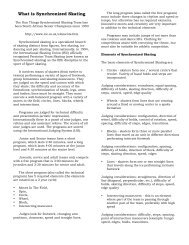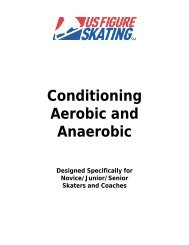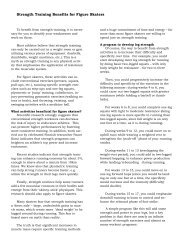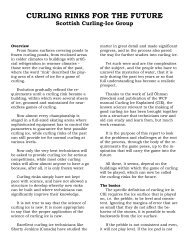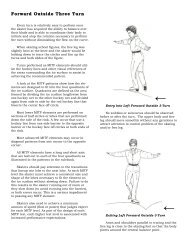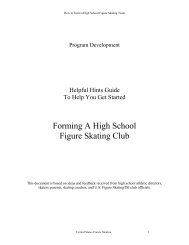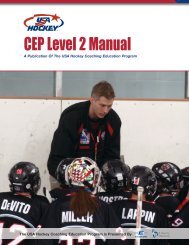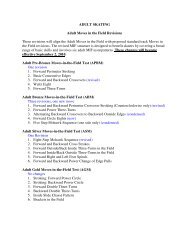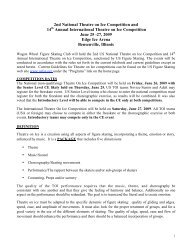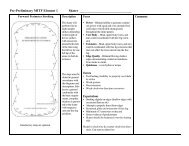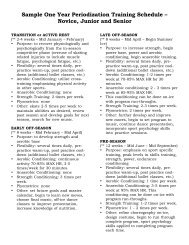CEP Level 3 Manual - Rushmore Hockey Association
CEP Level 3 Manual - Rushmore Hockey Association
CEP Level 3 Manual - Rushmore Hockey Association
Create successful ePaper yourself
Turn your PDF publications into a flip-book with our unique Google optimized e-Paper software.
T A B L E O F C O N T E N T SPERIODIZATION FOR HOCKEYFLEXIBILITYTRAININGMETABOLICTRAININGSPEED/PLYOS/COORDINATIONSTRENGTH POWERHighLow-aerobic andanaerobic thresholdLow levels of speedand coordinationtrainingModerate to lowlevels of powertrainingHigh foundation ofgeneral, max andabsolute strengthHighLow Aerobic,Low ModerateAnaerobicModerate levels ofspeed, coordination,plyos and agilityLow levels of powertrainingHigh foundation ofgeneral, max,absolute andtrainingendurance trainingHighLow Aerobic,Moderate anaerobicthreshold, max V02and lactic thresholdModerate levels ofspeed, coordination,agility and plyometricModerate to highlevels of powertrainingModerate-relative,endurance andspecific strengthModerate training tomaintenanceModerate to highlevels of AnaerobicHigh levels of speed,coordination, agilityand plyometrictrainingHigh level of powertrainingHigh level of specificstrengthMaintenanceHigh AnaerobicHigh levels of speed,coordination, agilityand plyometrictrainingModerate to highlevels of powertraining - complex andOlympic style IiftsMaintain strengthtraining and core liftsMaintenanceMaintain anaerobicintervals, primarilyon iceMaintain levels ofspeed, coordination,agility and plyometricMaintain high levels ofpower trainingMaintain - concentrateon specific strengthtraining (core andPREVENTION OF INJURYWhether you are dry land training, on thefield/court, or in the weight room, the ever presentrisk for injury is always looming. <strong>Hockey</strong>, at anylevel, has some amount of contact (body to body,body to ice, body to boards, body to puck, stick topuck). It is our goal through the proper trainingprograms to prepare the body’s joints, muscles, andbones to withstand the various positions a hockeyplayer might engage during the game. In order todo this, the training must be multi-directional,functional to their needs, and performed through asafe and effective range of motion with adequateflexibility.It is intended that all these exercises and drillsare to be monitored by a Strength and ConditioningSpecialist to ensure safety and proper form. As withall age levels, correct technique must be stressedand the proper form has to be mastered beforegoing on to any weight bearing exercise.Impatience with body weight and/or minimalresistance exercises at any age may lead to injury.Although preventing an injury is not guaranteed,by performing a proper plyometric, agility, flexibility,and strength training program, the chances aredecreased.STRENGTH AND CONDITIONING GUIDELINESBody Weight and Free Weight ExercisesA. Perfect form is a must, there are noexcuses for performing an exercise or liftingweight without perfect form. Do notsacrifice for heavy weights. It typically leadsto injury.B. Perform in a slow and controlled manner(except Olympic lifts).C. Body alignment (knee tracking, lordoticcurve, head neutral, weight distribution).D. Avoid rounding the lower back.E. Ask questions if you do not know how, ifyou don’t something will usually go wrong.F. Progressive Overload - start with a widevariety of body weight exercises. Thenprogress to light weights, do not rush. A 2.5pound increase per week over a year resultsin a total increase of 130 pounds.G. Closed Chain vs. Open Chain exercises -<strong>Hockey</strong> is played, for the most part, on oneleg. Strength training should be as sportspecific as possible. Closed Chain exercisesare those which are more functional towardsthe game involving more than one joint at atime. Having one foot or two feet in contactwith the ground or apparatus is classified as aClosed Chain exercise. Open Chainexercises usually involve only one joint ormuscle group. These types of exercises aretypically used at the earlier stages of rehaband are not as functional to a healthy athlete.Remember that the body is the ultimate freeweight.H. Overhead pressing movements are to bedone with the knees bent, hips pushed back,and head forward in order to reduce thestrain on the lower back.I. In any type of squat motion the kneesmust remain over the ankles as the hips movedown and back so that the thigh bone isparallel to the floor/ice.J. Once the body weight exercises havebeen mastered, vary the tempo by controllingthe eccentric (lowering) and concentric(raising) speeds.OFFSEASONHypertrophy ActiveRest - 3 weeksOFF SEASONHypertrophyPRE-SEASONPRE-SEASON Basicstrength to Strengthand PowerIN-SEASONStrength and Powerto PeakIN-SEASONPLAYOFFS PeaktrainingtrainingtrainingOlympic style lifts)138 | USA <strong>Hockey</strong> Coaching Education Program <strong>Level</strong> 3 <strong>Manual</strong>Growth and Fitness Development | 139



